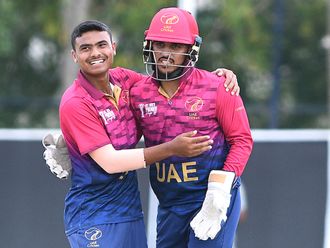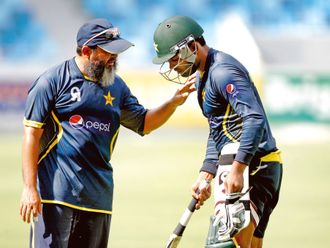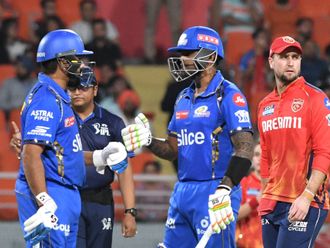London: No one can accuse the Test series against South Africa of being boring; indeed, one’s only regret is that it is just to be four Tests — the last of which starts at Old Trafford on Friday — rather than the five two such well-matched sides merit.
But perhaps one of the few benefits of the decline of Test cricket — or rather, the decline in the number of sides capable of sustaining the game at a high level over a long series — is that there will be less to squeeze in over the years ahead, and teams of South Africa’s calibre will always merit the full five matches.
The roller-coaster nature of the fortunes in this series suggests two teams in which consistency is not paramount.
For England, it seems to be a problem of having only two or three batsmen who can easily make the transition from short-form to first-class cricket.
Joe Root and Ben Stokes can do this because of excessive talent, and Jonny Bairstow is almost in their league; the other hugely gifted batsman in the side, Alastair Cook, no longer plays limited-over matches at international level.
For England’s other batsmen there are shortcomings of technique, not least as seen in their first-innings dismissals at the Oval, that suggest a failure to recall, in a split second, what sort of game they are playing.
Fortunately for England, South Africa seem from time to time afflicted with the same difficulties: though the technique of South African batsmen, honed on very different surfaces, seems fundamentally more reliable.
Something similar is often true of Australian players, whom England will shortly confront on their winter tour. Australia has the habit of finding batsmen of the quality of Cook and Root somewhat more often than we do.
Over the years, batsmen I have discussed this with have put it down to learning how to bat on truer surfaces and developing a better technique as a consequence: and players of the older school contend that the only way to cope with English conditions was to practise, and especially to have more match practice.
With the County Championship cut to 14 matches, touring sides having slashed the amount of county matches they play, and England players never or rarely playing county cricket during the international programme, opportunities are limited. When one sees the absence of first-class cricket for the South Africans since the last Test it seems that want of match practice may not be a problem for England alone.
The Tests so far have given England plenty of cause to feel optimistic about the trip to Australia; but although South Africa are an impressive unit this is far from being the best team the Proteas have sent here since the resumption of their international life nearly 25 years ago.
After the Old Trafford Test England have three Tests against West Indies, whose recent record has been pitiful.
Unless the late summer weather intrudes, the least England should expect is a 3-0 victory. Even then, sadly, it will be no indication of how they should do against Australia. Cook, Root, Stokes, Bairstow, Stuart Broad and Anderson should all be picked.
Impressive newer players such as Tom Westley and Toby Roland-Jones should join them; but many other slots are up for grabs, and the rest of the squad is likely to be composed mainly of men who have made an uncertain start in Test cricket. England have insisted on three first-class matches before the Ashes starts, and there will be another between the second and third Tests.
Whether that will prove enough is hard to tell: it did not in 2013-14, when rained intervened, notably in Hobart. Despite the experience of the key players, the mostly creditable Test performances this summer, and Root appearing to be progressing successfully as captain, one still gets the sense that our Test cricketers play too little first-class cricket to be really sure of their chances against Australia.
Most of what has gone wrong for England this summer — as in the Trent Bridge Test — can be attributed to too little long-form cricket and too much short-form.
One cannot complain that market forces now dictate the nature of cricket, because that is all part of the privilege of living in a free society; but cricket authorities are going to have to do more to support the long game unless they want the short one to kill it completely. Last month Mike Brearley warned the authorities that the decision by A B de Villiers not to play for South Africa, but to take a “sabbatical” from the first-class game, was a “red flag” for the future of Test cricket.
It was widely reported, and coming from such a source was an authoritative statement, but who is listening?
Great players do not really want to play first-class cricket and some of them do not even want to play Test cricket.
Fewer people want to watch first-class cricket because it seems dull and goes beyond their attention spans, and Test cricket is, as Brearley has correctly identified, starting to go the same way. I hope it does not take another hammering in Australia to make the cricket authorities here sit up and take notice.
The problem is that excuses can always be found to avoid admitting the real causes of the malaise. But in the end the truth is unavoidable: if we want to play the best possible Test cricket we need to train our Test cricketers, and we train them best in the first-class game. To do that we need more first-class cricket, not the derisory 14-match championship of this season — and to make it meaningful it needs to be made less attritional and faster-paced.
It has to be better marketed and staged when people are free to watch it — which means the experiment with day/night first-class matches must be extended.
But thought will also have to be given to just how compatible T20 and Test cricket are with each other. The authorities must stop navel-gazing and consider a formal distinction between two codes of cricket.
Otherwise the roller-coaster of Test cricket, fighting against extinction, that we are currently experiencing, will become all downhill.











